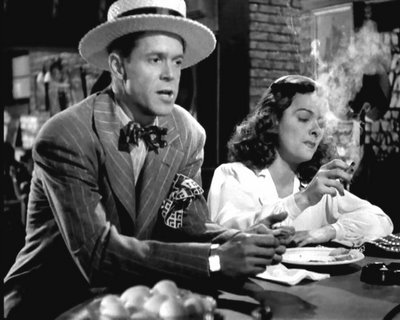Bennett started getting better roles in such costume dramas as The Man in the Iron Mask and The Son of Monte Christo. The turning point in her career came in 1941 when legendary director Fritz Lang cast her in Man Hunt. Playing a cockney streetwalker helping Walter Pidgeon escape the Nazis, Bennett was charming if not totally believable—but she was gorgeous.
Finally a major star, Bennett made The Macomber Affairwith Gregory Peck and the last of her four Lang films, Secret Beyond the Door.... She ended the 1940s with the excellent The Reckless Moment directed by Max Ophüls and co-starring James Mason. Bennett then started the ‘50s playing Elizabeth's Taylor's mother in Father of the Bride, which was another big hit.
 Scarlet Street has been claimed by film noir.
Scarlet Street has been claimed by film noir. The real break came in 1944 with Lang’s masterpiece The Woman in the Window, co-starring Edward G. Robinson. The exciting film noir was a smash hit with a twist ending and for the first time Bennett was not only sexy, glamorous and box office, but she was fascinating as the title character opposite the superb Robinson. Bennett, Robinson and director Lang followed this hit with the classic Scarlet Street, a film so bleak and despairing that it was banned in some US states. Many film critics consider this not only Lang's greatest American film but also the peak of Bennett's career. Playing a conniving tramp with Dan Duryea in fine support, Bennett was mesmerizing as the evil Kitty.
This attribution is understandable.The lighting is dark, with heavy use of shadows.
The characters are all shady as well.
Kitty is certainly a femme fatale, although hints are dropped that she is an inherently decent person who has become completely corrupted by Johnny.
Being the most naive, Robinson is also the most sympathetic.
But even he eventually turns to crime to fulfill his passions.

But while Scarlet Street has elements of film noir, it is in reality a black comedy.
While Robinson plays it straight throughout, Bennett and Duryea camp it up marvelously.
Bennett laughs when Robinson claims to be a painter: "And here I had you pegged as a cashier!" She also has to suppress laughter when Robinson reveals that he is married, and shock when Duryea passes her off as the mysterious painter.
_01.jpg)
Then in 1951 Bennett became involved in one of the biggest scandals of the decade. She and her agent, Jennings Lang, were in a parked car "discussing business" when Bennett’s husband, producer Walter Wanger,

discovered them and shot Lang in the "groin," as the LA press coined it. The resulting scandal sent Wanger to prison and caused Bennett to be virtually blacklisted in Hollywood. (Bennett denied any romance, and she and Wanger remained married until 1965.)
Bennett's friend Humphrey Bogart insisted that she be his leading lady in We're No Angels, but due to the scandal and her advancing age her film career was over. Bennett’s career entered a new phase when she was cast in the Gothic TV soap Dark Shadows, which ran 5 years and earned her an Emmy nomination. Bennett died in 1990 at the age of 80.
Bennett's four films with Fritz Lang and her other 1940s work are a living testament to the beauty and talent of this lovely lady. If you have to rent one DVD from her career check out The Woman In The Window. It is a classic and more than enough to justify Bennett’s position as one of the great Hollywood stars.
No comments:
Post a Comment